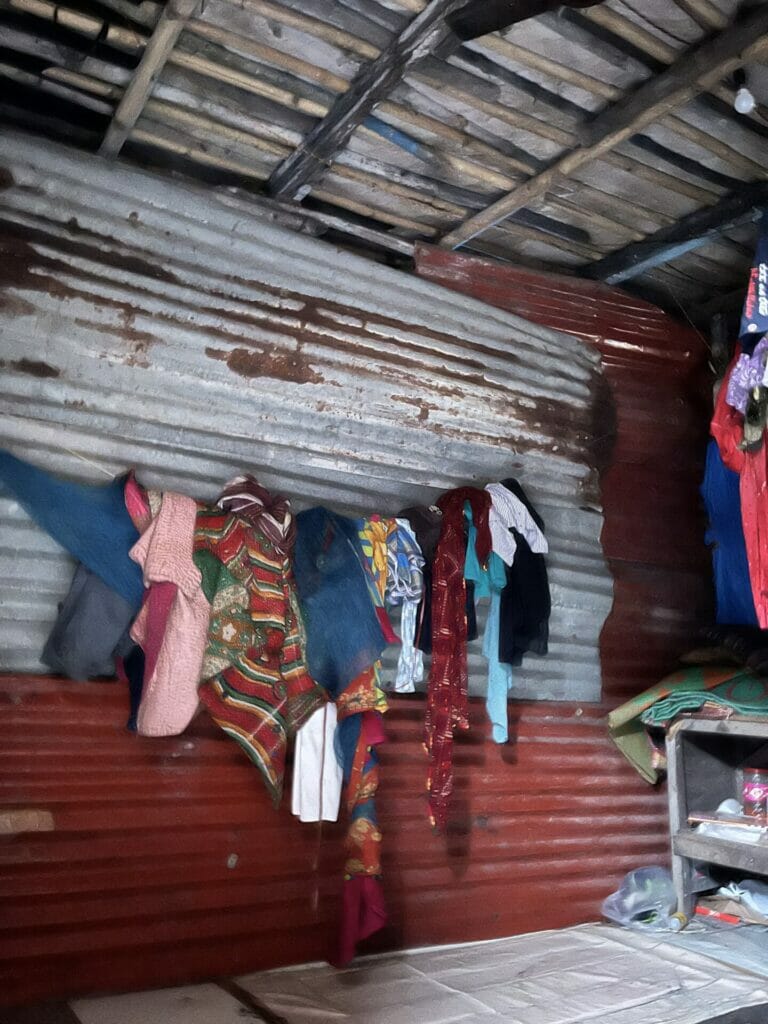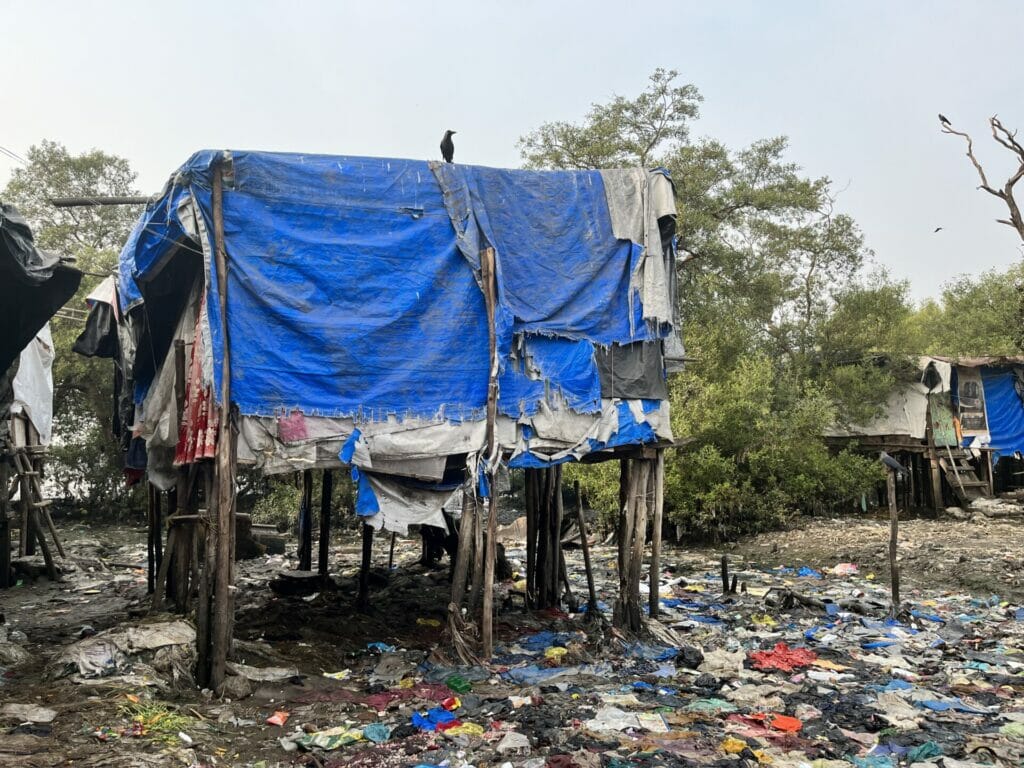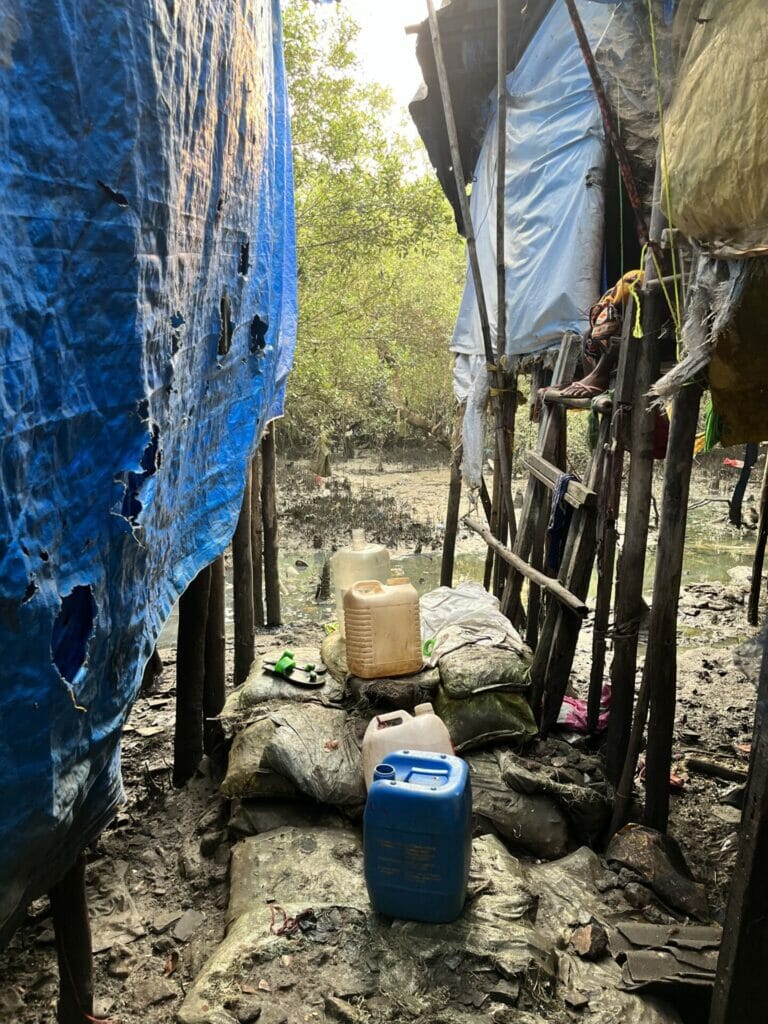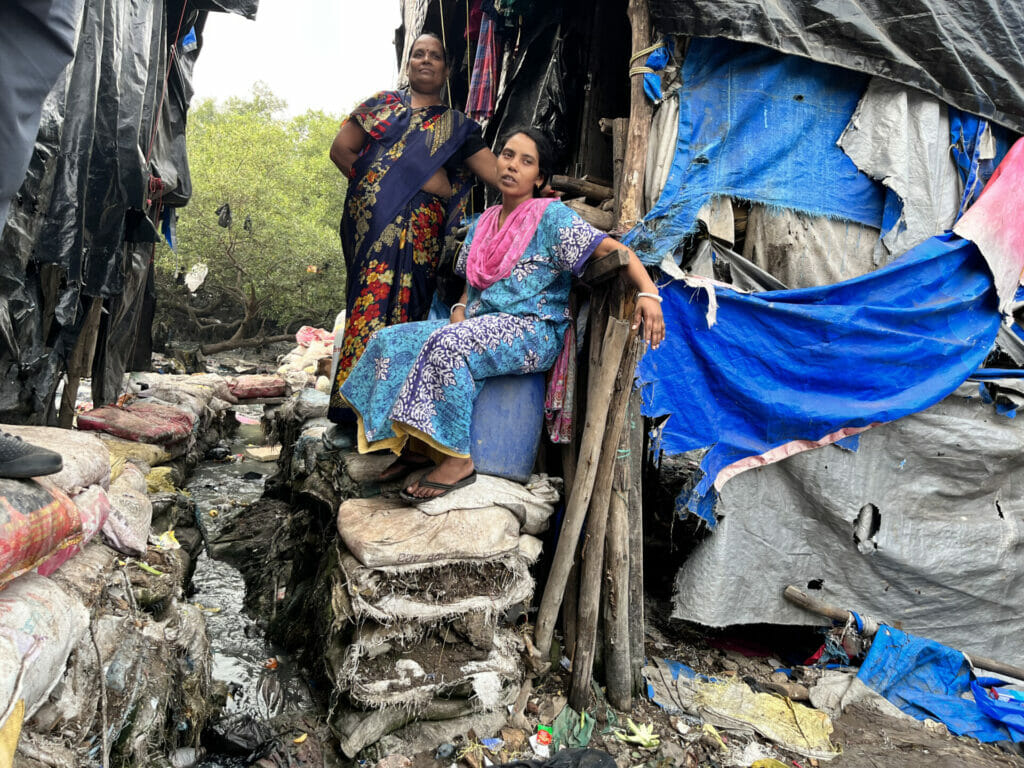Weeks before her daughter was born, a heavily pregnant Chandni Bibi boarded a train to Murshidabad in West Bengal, from where she had another hour’s journey to her native village. Had she decided to deliver her baby in Mumbai, she would have to navigate the waist-high tidal waters that flooded the area around her home twice every day. A single room built of wood and sheets of scrap metal in a slum, her home stands on uneven wooden and bamboo poles driven into the soft soil where land meets the sea.
Among an estimated 6,000 homes built on the coastal fringe of Cuffe Parade, from Ambedkar Nagar to Ganesh Nagar and Murti Nagar, Chandni’s tarpaulin roof has been whipped off by monsoon gusts on several occasions, drenching the family of five and their meagre stock of foodgrain. “We crowd into somebody else’s home until it’s fixed,” she says. “The rains have been so harsh in recent years, every monsoon somebody’s house is destroyed completely. Nobody is spared.”
Her husband suffered a paralytic stroke after an unexplained fever, and no longer works. She herself has suffered from a persistent cough, but there is neither money for a doctor nor time to recuperate. “I’m just exhausted all the time,” says the mother of three.
Impact of climate change on housing in Mumbai’s slums
For the six million Mumbaikars who live in informal housing, climate conditions have steadily worsened over the past decade. Flooding of homes in slum clusters is more frequent, with every flooding episode causing more damage to property.
Read more: Climate change, rainfall patterns and what it means for Mumbai’s monsoon
A 2015 report commissioned by the World Bank Group found that a significantly large proportion of poor households were located near areas with chronic flooding, rendering them at severe risk from rising sea levels and storm surges. According to the latest Intergovernmental Panel On Climate Change (IPCC) report, global warming is expected to exceed the 1.5°C benchmark, exposing cities to floods, extreme heat, storm surges and cyclones. Some of these have already begun to occur.
Livelihoods in Mumbai slums at stake
Across Chandni’s home, also on stilts, lives Serafoon Bibi. “You could suffer the heat and the storms if work was good, but we are no longer able to earn enough money,” she says. The Bengali families in this garbage-strewn patch of Ambedkar Nagar work at Sassoon Docks, twisting the heads off fish that are sent for processing as sliced steaks or fillets. The pay is Rs 2 for a kilo of de-headed fish.
According to Serafoon, who migrated from Murshidabad only three years ago, the catch is much less now than when she first arrived. “We used to earn Rs 400-Rs 500 a day,” she says, “and now sometimes we don’t even make Rs 50. Maal hi nahi hai. (There’s no catch.)”
Serafoon describes a vicious cycle succinctly: As landless poor, they came to Mumbai because agricultural wages in her home district were very low, her husband suffered an arm injury and financial losses when he tried to work as a mason in Saudi Arabia, but in Mumbai the losses continue to mount as the catch of fish shrinks. Meanwhile they deplete their small savings every time the house is damaged during the monsoon or every time one of the three children falls sick with flood-related diseases such as diarrhoea or typhoid fever.

Worsening health and climate change
This year, hospitals reported a spike in heat-related ailments such as exhaustion, heat-stroke, nausea, headaches during a heatwave-like period in March 2022 – an unprecedented climate incident in the financial capital.
Prakash Chavan’s Rainbow Foundation conducted several grocery and food distribution drives in Ambedkar Nagar during the pandemic. He said the houses on the edge of the sea tend to belong to those without ration cards, very poor families without access to India’s food security programme, many suffering from routine nutritional deficiencies. Serafoon, Chandni and several others in Ambedkar Nagar said they have never tried to get state-funded medical insurance.


Shweta Damle, founder of Habitat And Livelihood Welfare Association (HALWA), says hot days have increased, as have rainy days, leading to increased vulnerability to climate-related health concerns — mainly respiratory diseases from aerosols in the air and skin problems due to extreme heat combined with poor hygiene practices caused by poor availability of sanitation.
“Especially in dense slums, all the children have boils in the summer months, much more frequently than earlier,” says Damle, who has worked for over two decades on slum-dwellers’ issues in Mumbai. “Sore eyes, breathing problems caused by poor ventilation and aerosols, these are rising.”
According to the World Health Organization, extreme heat exposure may cause heat exhaustion and heat strokes, a condition which causes faintness, as well as dry, warm skin as the body fails to regulate its temperatures. Other symptoms include swelling in the lower limbs, heat rash on the neck, cramps, headache, irritability, lethargy and weakness. “Acute cerebrovascular accidents” may result from heat-waves too, the WHO says. Additionally, people with chronic diseases who take daily medications have a greater risk of complications, and death during a heatwave, so do older people and children.
Climate change adds to expenses
As the number of days of heat rain rises, people are forced to make greater investment in proper roofing, protection of their belongings, etc, as well as on medical expenditure and on replacing lost assets.

“Hardships for the urban poor have increased on account of climate,” she says. “And they will face more difficult times in coming years through loss of wages when they’re unable to go to work on very hot days or when low-lying areas get flooded.”
Read more: Livelihoods under severe stress as climate change impacts Mumbai’s dried fish sector
A short walk from HALWA’s office in a Bandra Reclamation slum, autorickshaw driver Aslam Shaikh lives in a shanty made of tin sheets. The house is like a sauna in the summer. “More and more, we’re sweating inside, and breathless,” says Tehmida, his wife. “Earlier we used to drench gunny bags in water and put them on the roof for cooling, but now it’s dangerous with all the electric cables criss-crossing overhead.”

Bleak times ahead
Multiple reports have said the urban poor will be the most vulnerable to climate change impact in cities such as Mumbai. However, official mitigation plans do not include any outreach work in the slums to educate residents on how to tackle the coming change, says Damle.
The Shaikhs spend long parts of summer days outdoors in the bylanes of the slum or on the roadside. “In the rains we can’t even do that,” says Aslam, adding that the monsoon has become, in recent years, an annual trail of expenditure. “Even when secured with rope, the plastic and tarpaulin sheets on the roof fly off in the wind, sometimes the entire roof is uprooted. The kids fall sick, sometimes everything is wet for a week to ten days.”
On a particularly rainy day in 2020, the Shaikhs’ neighbour went to pick up their children from school. When they got back, they found that the entire mezzanine floor had collapsed. It took more than a year for them to save up money to rebuild parts of it.
An exhausted Serafoon says she allows her daughter Sharifa to accompany her to the docks while she’s working. “She gives me a helping hand,” says the mother.
The 11-year-old girl who studies in the Urdu medium section of a municipal school says she helps remove the head or the belly flap of fish. Pointing to a tiny scratch near the cuticle of her left thumb, she says the fish scales are sometimes rough, and she has to walk a long distance to the designated spot where the heads are discarded. On very hot days, she gets home exhausted. “My feet hurt, my fingers burn,” she says. “But the next day we go back anyway.”